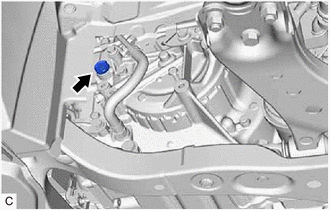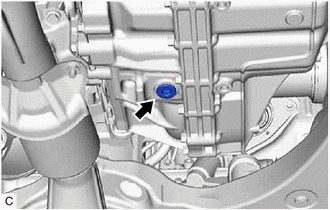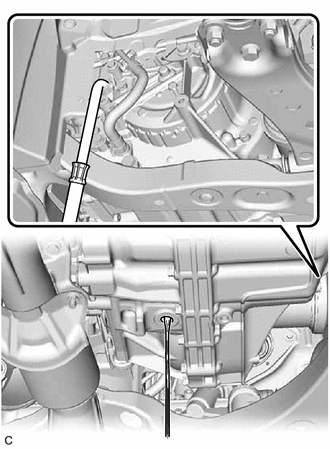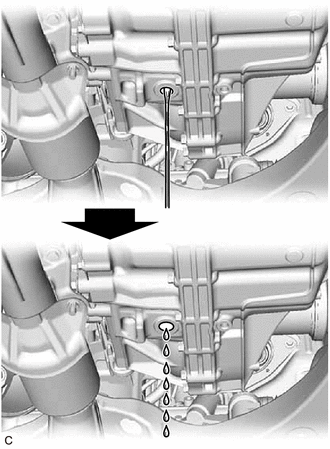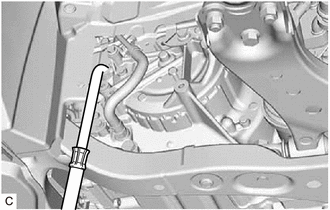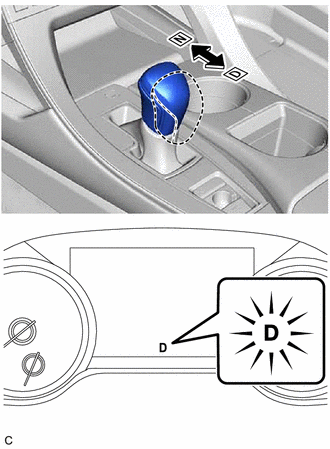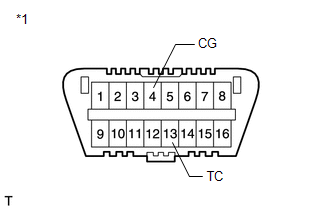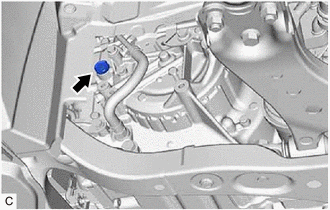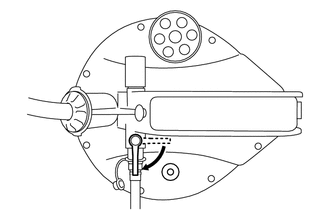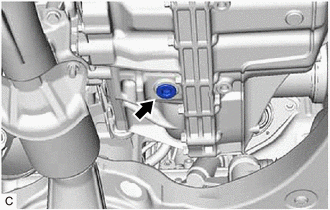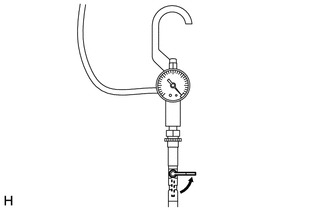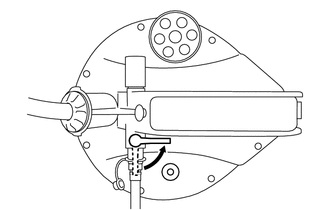Adjustment
ADJUSTMENT
CAUTION / NOTICE / HINT
The
necessary procedures (adjustment, calibration, initialization or
registration) that must be performed after parts are removed and
installed, or replaced during automatic transaxle fluid replacement are
shown below.
Necessary Procedures After Parts Removed/Installed/Replaced |
Replaced Part or Performed Procedure |
Necessary Procedure | Effect/Inoperative Function when Necessary Procedure not Performed |
Link |
| Replacement of automatic transaxle fluid |
ATF thermal degradation estimate reset |
The value of the Data List item "ATF Thermal Degradation Estimate" is not estimated correctly |
 |
PROCEDURE
1. PRECAUTIONS AND WORK DESCRIPTION
(a)
The UA80E automatic transaxle assembly does not have an oil filler tube
and oil level gauge. When adding automatic transaxle fluid, add
automatic transaxle fluid through the refill hole on the automatic
transaxle case sub-assembly. The automatic transaxle fluid level can be
adjusted by draining excess automatic transaxle fluid (allowing excess
automatic transaxle fluid to overflow) through the overflow plug of the
transaxle housing.
HINT:
"Overflow" indicates the condition under which automatic transaxle fluid comes out of the overflow plug hole.
(b)
Before adjusting the automatic transaxle fluid level, add the specified
amount of automatic transaxle fluid when the engine is cold and warm up
the engine to circulate the automatic transaxle fluid in the automatic
transaxle assembly. Ensure that the automatic transaxle fluid
temperature is as specified and the engine is idling.
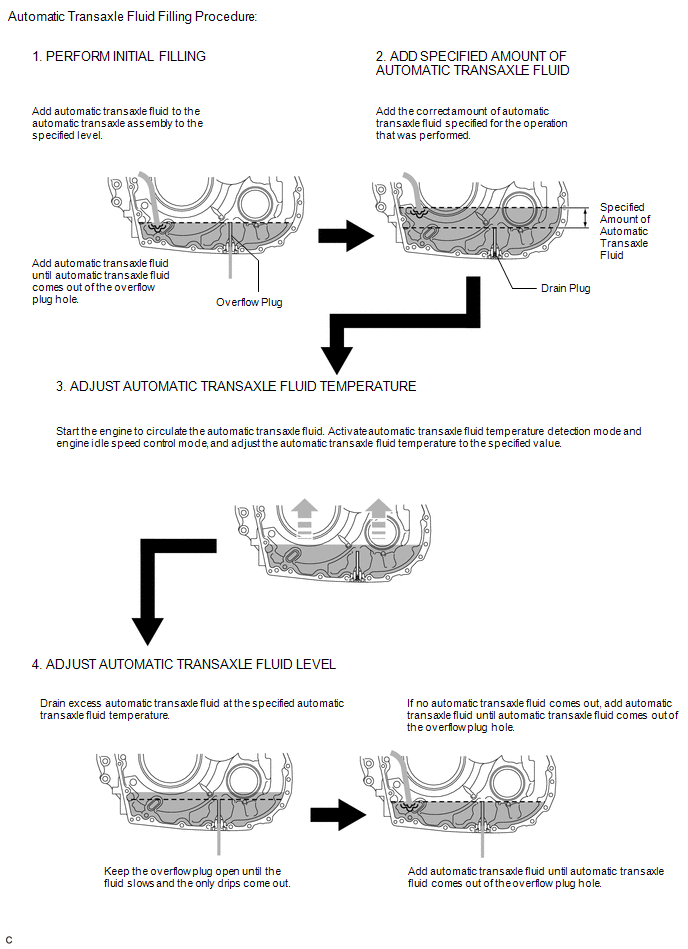
(c) The UA80E automatic transaxle assembly requires Toyota Genuine ATF WS.
(d) The adjustment should be performed according to the procedures and notes.
2. WORK FLOW
(a) The adjustment should be performed according to the procedure referenced in the work flow below.
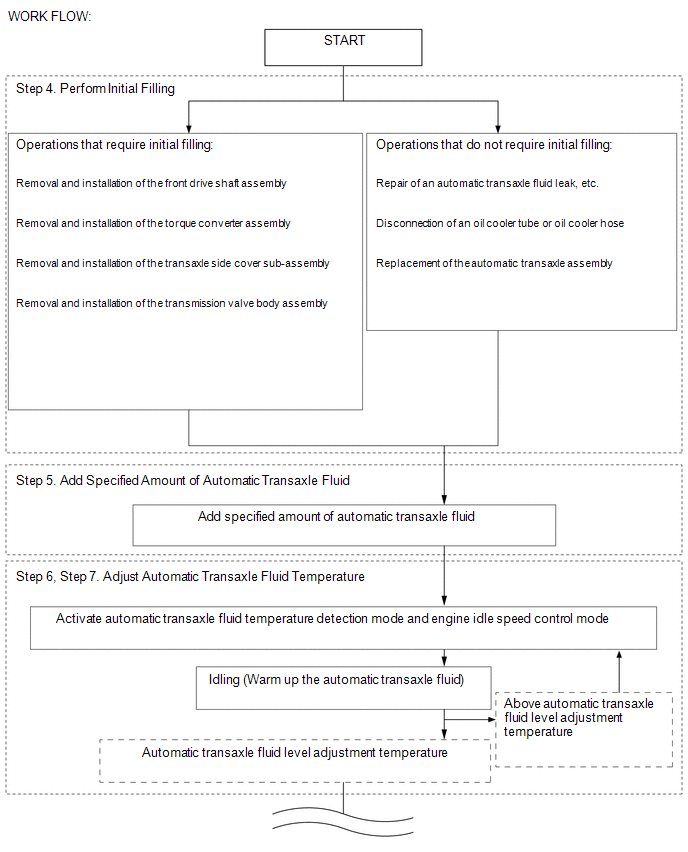
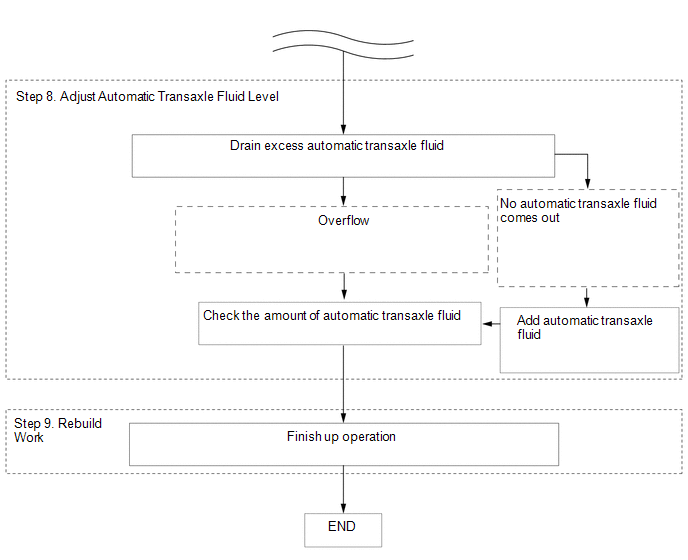
3. PREPARATION WORK
(a) Lift the vehicle.
NOTICE:
Set
the vehicle on a lift so that the vehicle is kept level when it is
lifted up (make sure that the tilt angle from the front to rear and side
to side of the vehicle is within +/- 1°).
(b) Remove the front wheel opening extension pad LH.
Click here 
(c) Remove the front wheel opening extension pad RH.
Click here 
(d) Remove the No. 1 engine under cover.
Click here 
(e) Remove the rear engine under cover LH.
Click here 
(f) Remove the front fender apron seal LH.
Click here 
4. PERFORM INITIAL FILLING
NOTICE:
If
the automatic transaxle assembly is hot (automatic transaxle fluid
temperature is high), wait until the automatic transaxle fluid
temperature becomes the same as the ambient temperature before starting
the following procedure. (Recommended automatic transaxle fluid
temperature: around 20°C (68°F))
| (a) Remove the refill plug and gasket from the automatic transaxle case sub-assembly.
NOTICE: After
performing either of the following operations, it is not necessary to
perform the initial filling procedure. Proceed to the "Add Specified
Amount of Automatic Transaxle Fluid" procedure. |
Operations that do not require initial filling |
- Disconnection of an oil cooler tube or oil cooler hose
- Repair of an automatic transaxle fluid leak due to a loose case plug, or a faulty plug gasket or O-ring
- Replacement of the automatic transaxle assembly
| | |
| (b) Using a 10 mm hexagon socket wrench, remove the overflow plug and gasket from the transaxle housing.
NOTICE:
- If automatic transaxle fluid comes out after removing the overflow plug,
wait until the automatic transaxle fluid flow slows and only drips come
out.
- If automatic transaxle fluid comes out, it is not necessary to perform
the initial filling procedure. After checking the tightening torque of
the No. 1 transmission oil filler tube, temporarily install the overflow
plug.
| |
| (c) Using a 6 mm hexagon socket wrench, check that the No. 1 transmission oil filler tube is tightened to the specified torque.
Torque: 1.7 N·m {17 kgf·cm, 15 in·lbf} NOTICE: If
the No. 1 transmission oil filler tube is not tightened to the
specified torque, the amount of automatic transaxle fluid cannot be
precisely adjusted. HINT: To
check the torque of the No. 1 transmission oil filler tube, insert the 6
mm hexagon socket wrench into the overflow plug hole. |
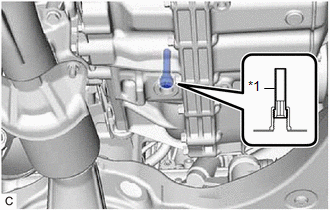 |
|
*1 | No. 1 Transmission Oil Filler Tube | | |
(d) Perform initial filling.
| (1)
Fill the automatic transaxle assembly through the refill hole until
automatic transaxle fluid begins to come out of the overflow plug hole. NOTICE:
Use Toyota Genuine ATF WS. | |
| (e) Wait until the automatic transaxle fluid flow slows and only drips come out. |
|
| (f) Using a 10 mm hexagon socket wrench, temporarily install the gasket and overflow plug to the transaxle housing.
HINT: Reuse the old gasket as the overflow plug will be removed again to adjust the automatic transaxle fluid level. |
|
| (g) Temporarily install the gasket and refill plug to the automatic transaxle case sub-assembly.
HINT: Reuse the old gasket as the refill plug will be removed again to adjust the automatic transaxle fluid level. |
|
5. ADD SPECIFIED AMOUNT OF AUTOMATIC TRANSAXLE FLUID
| (a) Remove the refill plug and gasket from the automatic transaxle case sub-assembly. |
|
| (b) Fill the automatic transaxle assembly with the correct amount of automatic transaxle fluid as listed in the table below.
NOTICE: Use Toyota Genuine ATF WS. HINT: The refill amount differs depending on the operation that was performed.
Reference Capacity: |
Performed Repair | Fill Amount | |
Automatic transaxle assembly replacement (with a new torque converter assembly) |
5.2 liters (5.5 US qts, 4.6 Imp. qts) | |
Automatic transaxle assembly replacement (when reusing the torque converter assembly) |
4.8 liters (5.1 US qts, 4.2 Imp. qts) | |
Removal and installation of the transaxle side cover sub-assembly |
3.0 liters (3.2 US qts, 2.6 Imp. qts) | |
Removal and installation of a front drive shaft assembly |
3.0 liters (3.2 US qts, 2.6 Imp. qts) | |
Removal and installation of the transmission valve body assembly |
3.0 liters (3.2 US qts, 2.6 Imp. qts) | |
Removal and installation of the torque converter assembly |
3.0 liters (3.2 US qts, 2.6 Imp. qts) | |
Repair of an automatic transaxle fluid leak due to a loose case plug, or a faulty plug gasket or O-ring |
0.5 liters (0.5 US qts, 0.4 Imp. qts) | |
|
| (c) Temporarily install the gasket and refill plug to avoid automatic transaxle fluid spillage.
HINT: Reuse the old gasket as the refill plug will be removed again to adjust the automatic transaxle fluid level. |
|
(d) Lower the vehicle.
6. ADJUST AUTOMATIC TRANSAXLE FLUID TEMPERATURE (when Using the Techstream)
HINT:
The actual automatic transaxle fluid temperature can be checked on the Data List using the Techstream.
(a) Connect the Techstream to the DLC3 with the engine switch off.
(b) Turn the engine switch on (IG) and turn the Techstream on.
NOTICE:
To
reduce load, make sure that all electrical systems, such as the air
conditioning, lighting system, electric fan and audio system are off.
(c) Enter the following menus: Powertrain / Transmission / Active Test / Activate the TC Terminal.
Powertrain > Transmission > Active Test
|
Active Test Display |
|
Activate the TC Terminal |
|
Data List Display |
|
A/T Oil Temperature No.1 |
(d) According to the display on the Techstream, perform the Data List "A/T Oil Temperature No.1".
(e) According to the display on the Techstream, perform the Active Test Activate the TC Terminal and set it to "ON".
(f) Check the automatic transaxle fluid temperature.
NOTICE:
- If the automatic transaxle fluid temperature is below 45°C (113°F),
proceed to the next step. Recommended automatic transaxle fluid
temperature: 35°C (95°F) or less
- If the automatic transaxle fluid temperature is 45°C (113°F) or more,
turn the engine switch off and wait until the automatic transaxle fluid
temperature drops below 45°C (113°F).
(g) Depress and hold the brake pedal.
(h) Start the engine.
(i) Slowly move the shift lever from P to D, then back to P.
HINT:
- Slowly move the shift lever to circulate the automatic transaxle fluid through each part of the automatic transaxle assembly.
- Keep the shift lever in each position for approximately 3 seconds.
| (j)
While observing the D shift indicator on the combination meter, move
the shift lever back and forth between N and D at an interval of less
than 1.5 seconds for 6 seconds or more. NOTICE: Do not pause for more than 1.5 seconds.
HINT: Performing this operation will cause the vehicle to enter automatic transaxle fluid temperature detection mode. |
|
(k) Check that the D shift indicator comes on for 2 seconds.
HINT:
- When automatic transaxle fluid temperature detection mode is activated,
the D shift indicator on the combination meter comes on for 2 seconds.
- If the D shift indicator does not come on for 2 seconds, return to the
first step (perform the Active Test Activate the TC Terminal and set it
to "ON") and perform the procedure again.
(l) Move the shift lever to P.
(m) Release the brake pedal.
(n) According to the display on the Techstream, perform the Active Test Activate the TC Terminal and set it to "OFF".
NOTICE:
Make
sure that the Active Test is changed to "OFF". If it is not, the
automatic transaxle fluid level cannot be precisely adjusted due to
fluctuations in engine speed.
HINT:
- Changing the Active Test to "OFF" activates engine idle speed control mode.
- In engine idle speed control mode, engine idle speed control starts when
the automatic transaxle fluid temperature reaches the specified
temperature and the engine speed is maintained.
- Even after the Active Test is changed to "OFF", automatic transaxle
fluid temperature detection mode will be active until the engine switch
is turned off.
(o) Adjust the automatic transaxle fluid temperature to the automatic transaxle fluid level adjustment temperature.
Automatic Transaxle Fluid Temperature |
Below Automatic Transaxle Fluid Level Adjustment Temperature |
Automatic Transaxle Fluid Level Adjustment Temperature |
Above Automatic Transaxle Fluid Level Adjustment Temperature |
|
35°C or less (95°F or less) | 35 to 45°C
(95 to 113°F) | 45°C or more (113°F or more) |
NOTICE:
- If the automatic transaxle fluid temperature is within the automatic
transaxle fluid level adjustment temperature range, immediately proceed
to the "Adjust Automatic Transaxle Fluid Level" procedure.
- If the automatic transaxle fluid temperature is 45°C (113°F) or more,
stop the engine and wait until the automatic transaxle fluid temperature
drops to 40°C (104°F) or less. Then perform the "Adjust Automatic
Transaxle Fluid Temperature" procedure again from the beginning.
HINT:
In
automatic transaxle fluid temperature detection mode, the D shift
indicator comes on, turns off or blinks depending on the automatic
transaxle fluid temperature.
D Shift Indicator |
Below Automatic Transaxle Fluid Level Adjustment Temperature (35°C or less)
(95°F or less) | Automatic Transaxle Fluid Level Adjustment Temperature
(35 to 45°C) (95 to 113°F) | Above Automatic Transaxle Fluid Level Adjustment Temperature
(45°C or more) (113°F or more) |
|
OFF | ON |
Blinks |
7. ADJUST AUTOMATIC TRANSAXLE FLUID TEMPERATURE (when Not Using the Techstream)
| (a) Using SST, connect terminals 13 (TC) and 4 (CG) of the DLC3 with the engine switch off.
SST: 09843-18040 | |
(b) Depress and hold the brake pedal.
(c) Start the engine.
NOTICE:
To
reduce load, make sure that all electrical systems, such as the air
conditioning, lighting system, electric fan and audio system are off.
(d) Slowly move the shift lever from P to D, then back to P.
HINT:
- Slowly move the shift lever to circulate the automatic transaxle fluid through each part of the automatic transaxle assembly.
- Keep the shift lever in each position for approximately 3 seconds.
| (e)
While observing the D shift indicator on the combination meter, move
the shift lever back and forth between N and D at an interval of less
than 1.5 seconds for 6 seconds or more. NOTICE: Do not pause for more than 1.5 seconds.
HINT: Performing this operation will cause the vehicle to enter automatic transaxle fluid temperature detection mode. |
|
(f) Check that the D shift indicator comes on for 2 seconds.
HINT:
- When automatic transaxle fluid temperature detection mode is activated,
the D shift indicator on the combination meter comes on for 2 seconds.
- If the D shift indicator does not come on for 2 seconds, return to the
first step (connect terminals 13 (TC) and 4 (CG) of the DLC3) and
perform the procedure again.
(g) Move the shift lever to P.
(h) Release the brake pedal.
(i) Remove SST from terminals 13 (TC) and 4 (CG).
SST: 09843-18040
NOTICE:
Make
sure that the terminals are not connected. If the terminals are
connected, the automatic transaxle fluid level cannot be precisely
adjusted due to fluctuations in engine speed.
HINT:
- Disconnecting the terminals activates engine idle speed control mode.
- In engine idle speed control mode, engine idle speed control starts when
the automatic transaxle fluid temperature reaches the specified
temperature and the engine speed is maintained.
- Even after the terminals are disconnected, automatic transaxle fluid
temperature detection mode is active until the engine switch is turned
off.
(j) Allow the engine to idle until the D shift indicator comes on again.
D Shift Indicator |
Below Automatic Transaxle Fluid Level Adjustment Temperature (35°C or less)
(95°F or less) | Automatic Transaxle Fluid Level Adjustment Temperature
(35 to 45°C) (95 to 113°F) | Above Automatic Transaxle Fluid Level Adjustment Temperature
(45°C or more) (113°F or more) |
|
OFF | ON |
Blinks |
NOTICE:
- If the D shift indicator is on, immediately proceed to the "Adjust Automatic Transaxle Fluid Level" procedure.
- If the D shift indicator blinks, stop the engine and wait until the
automatic transaxle fluid temperature drops to 35°C (95°F) or less (the
indicator turns off). Then perform the "Adjust Automatic Transaxle Fluid
Temperature" procedure again from the beginning.
HINT:
- In automatic transaxle fluid temperature detection mode, the D shift
indicator comes on, turns off, or blinks depending on the automatic
transaxle fluid temperature.
- The automatic transaxle fluid filling procedure should be performed when
the D shift indicator is on (the automatic transaxle fluid temperature
is within the automatic transaxle fluid level adjustment temperature
range).
8. ADJUST AUTOMATIC TRANSAXLE FLUID LEVEL
CAUTION:
Use caution while the engine is idling and the radiator fans are operating.
(a) Lift the vehicle.
NOTICE:
Set
the vehicle on a lift so that the vehicle is kept level when it is
lifted up (make sure the tilt angle from the front to rear and side to
side of the vehicle is within +/- 1°).
| (b) Using a 10 mm hexagon socket wrench, remove the overflow plug and gasket from the transaxle housing.
CAUTION: Be careful as the automatic transaxle fluid coming out of the overflow plug hole is hot. |
|
(c) Check the amount of automatic transaxle fluid that comes out of the overflow plug hole.
- If the amount of automatic transaxle fluid that comes out of the overflow plug hole is large, proceed to step [#1].
- If no automatic transaxle fluid comes out of the overflow plug hole, proceed to step [#2].
NOTICE:
If
only a small amount of automatic transaxle fluid (approximately 1 cc)
comes out of the overflow plug hole, then only automatic transaxle fluid
remaining in the No. 1 transmission oil filler tube has come out. This
condition is not considered as overflow, so it is necessary to add
automatic transaxle fluid.
(d) If the amount of automatic transaxle fluid that comes out of the overflow plug hole is large. [#1]
| (1) Wait until the automatic transaxle fluid flow slows and only drips come out.
HINT: The
automatic transaxle fluid flow will not stop completely because the
automatic transaxle fluid continues to expand as its temperature
increases. | |
(e) If no automatic transaxle fluid comes out of the overflow plug hole. [#2]
| (1) Remove the refill plug and gasket from the automatic transaxle case sub-assembly. |
|
| (2) Add automatic transaxle fluid through the refill hole until automatic transaxle fluid comes out of the overflow plug hole.
NOTICE: Use Toyota Genuine ATF WS. | |
| (3) Wait until the automatic transaxle fluid flow slows and only drips come out. |
|
| (f) Using a 10 mm hexagon socket wrench, install the overflow plug and a new gasket to the transaxle housing.
Torque: 50 N·m {510 kgf·cm, 37 ft·lbf} NOTICE: To prevent the gasket from being deformed when tightening, coat it with Toyota Genuine ATF WS. |
|
| (g) Install the refill plug and a new gasket to the automatic transaxle case sub-assembly.
Torque: 49 N·m {500 kgf·cm, 36 ft·lbf} NOTICE: To prevent the gasket from being deformed when tightening, coat it with Toyota Genuine ATF WS. |
|
(h) Lower the vehicle.
(i) Turn the engine switch off.
HINT:
Turning the engine switch off ends automatic transaxle fluid temperature detection mode.
(j) Disconnect the Techstream from the DLC3 (when using the Techstream).
9. REBUILD WORK
(a) Lift the vehicle.
(b) Clean each part.
(c) Check for automatic transaxle fluid leaks.
(d) Install the front fender apron seal LH.
Click here 
(e) Install the rear engine under cover LH.
Click here 
(f) Install the No. 1 engine under cover.
Click here 
(g) Install the front wheel opening extension pad LH.
Click here 
(h) Install the front wheel opening extension pad RH.
Click here 
(i) Lower the vehicle.
Components
COMPONENTS
ILLUSTRATION
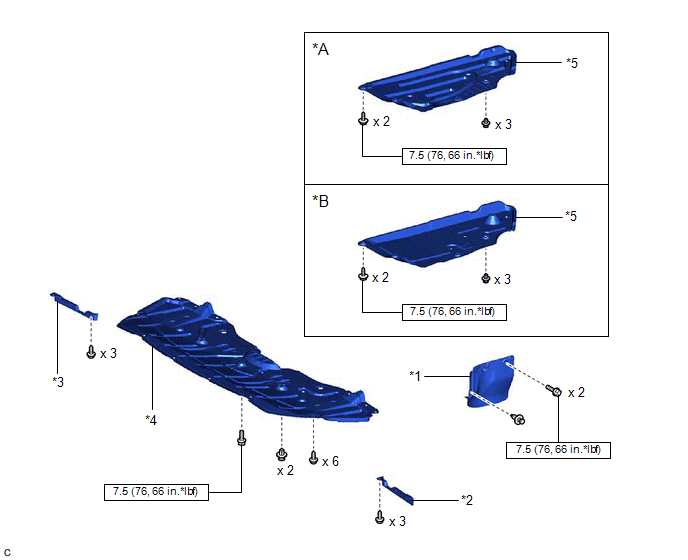
|
*A | Type A |
*B | Type B |
|
*1 | FRONT FENDER APRON SEAL LH |
*2 | FRONT WHEEL OPENING EXTENSION PAD LH |
|
*3 | FRONT WHEEL OPENING EXTENSION PAD RH |
*4 | NO. 1 ENGINE UNDER COVER |
|
*5 | REAR ENGINE UNDER COVER LH |
- | - |
 |
N*m (kgf*cm, ft.*lbf): Specified torque |
- | - |
ILLUSTRATION
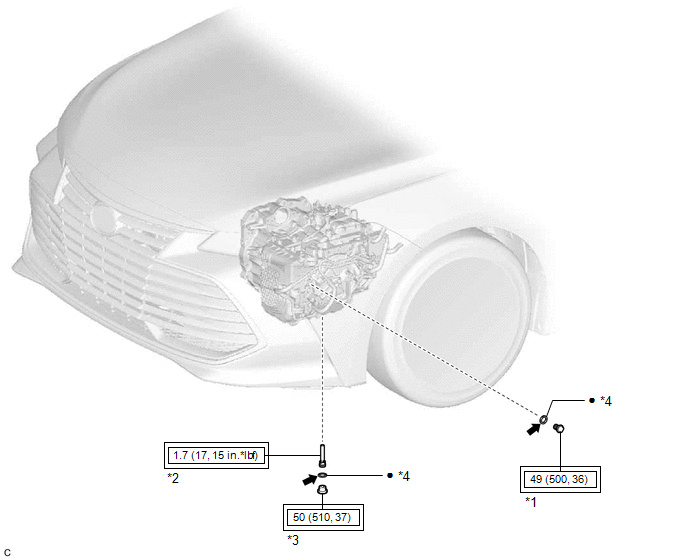
|
*1 | REFILL PLUG |
*2 | NO. 1 TRANSMISSION OIL FILLER TUBE |
|
*3 | OVERFLOW PLUG |
*4 | GASKET |
 |
Tightening torque for "Major areas involving basic vehicle performance such as moving/turning/stopping": N*m (kgf*cm, ft.*lbf) |
â—Ź | Non-reusable part |
 |
Toyota Genuine ATF WS |
- | - |
High Temperature Adjustment
HIGH TEMPERATURE ADJUSTMENT
CAUTION / NOTICE / HINT
The
necessary procedures (adjustment, calibration, initialization or
registration) that must be performed after parts are removed and
installed, or replaced during automatic transaxle fluid replacement are
shown below.
Necessary Procedures After Parts Removed/Installed/Replaced |
Replaced Part or Performed Procedure |
Necessary Procedure | Effect/Inoperative Function when Necessary Procedure not Performed |
Link |
| Replacement of automatic transaxle fluid |
ATF thermal degradation estimate reset |
The value of the Data List item "ATF Thermal Degradation Estimate" is not estimated correctly |
 |
CAUTION:
- Be careful not to burn yourself when the temperature of the automatic transaxle fluid is high.
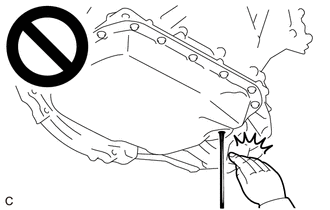
- To prevent injury due to contact with an operating V-ribbed belt or
cooling fan, keep your hands and clothing away from the V-ribbed belt
and cooling fans when working in the engine compartment with the engine
running or the engine switch on (IG).
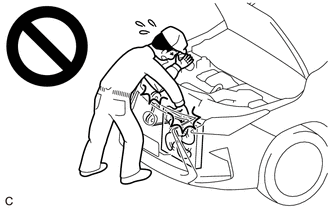
PROCEDURE
1. ADJUST AUTOMATIC TRANSAXLE FLUID LEVEL AT HIGH TEMPERATURE
(a) Warm up the engine and then turn the engine switch off.
(b) Check the automatic transaxle fluid temperature.
(1) Connect the Techstream to the DLC3 with the engine switch off.
(2) Turn the engine switch on (IG) and turn the Techstream on.
NOTICE:
To
reduce load, make sure that all electrical systems, such as the air
conditioning, lighting system, electric fan and audio system are off.
(3) Enter the following menus: Powertrain / Transmission / Data List / Engine Speed and A/T Oil Temperature No.1.
Powertrain > Transmission > Data List
|
Tester Display |
| Engine Speed |
|
A/T Oil Temperature No.1 |
NOTICE:
- If the automatic transaxle fluid temperature tends to decrease when the
automatic transaxle fluid temperature is between 85°C (185°F) and 90°C
(194°F) with the engine idling, make sure that automatic transaxle fluid
temperature is above 90°C (194°F) before starting work.
- If the automatic transaxle fluid temperature tends to increase when the
automatic transaxle fluid temperature is between 85°C (185°F) and 90°C
(194°F) with the engine idling, make sure that automatic transaxle fluid
temperature is below 85°C (185°F) before starting work.
- If the automatic transaxle fluid temperature tends not to change when
the automatic transaxle fluid temperature is between 85°C (185°F) and
90°C (194°F) with the engine idling, make sure that automatic transaxle
fluid temperature is 87.5°C (189.5°F) before starting work.
(c) Depress and hold the brake pedal.
(d) Start the engine.
(e) Slowly move the shift lever from P to D, and then back to P.
HINT:
- Slowly move the shift lever to circulate the automatic transaxle fluid through each part of the automatic transaxle assembly.
- Keep the shift lever in each position for approximately 3 seconds.
(f) Lift the vehicle.
NOTICE:
Set
the vehicle on a lift so that the vehicle is kept level when it is
lifted up (make sure the tilt angle from the front to rear and side to
side of the vehicle is within +/- 1°).
(g) Remove the front wheel opening extension pad LH.
Click here 
(h) Remove the front wheel opening extension pad RH.
Click here 
(i) Remove the No. 1 engine under cover.
Click here 
(j) Remove the rear engine under cover LH.
Click here 
(k) Remove the front fender apron seal LH.
Click here 
| (l) Remove the refill plug and gasket from the automatic transaxle case sub-assembly. |
|
| (m) Install SST (filler plug adapter) to the refill plug hole.
SST: 09993-19025 09993-10010 09993-01030 |
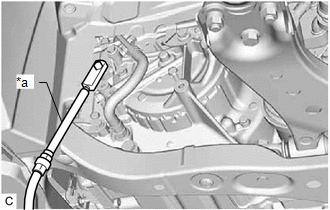 |
|
*a | SST (Filler Plug Adapter) | | |
| (n) Connect SST (vacuum regulator) to SST (filler plug adapter).
SST: 09993-19025 09993-10010 09993-01020 |
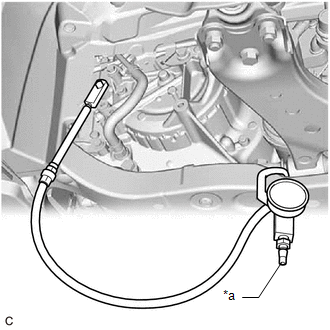 |
|
*a | SST (Vacuum Regulator) | | |
| (o) Connect the hose of SST (tank assy) to SST (vacuum regulator).
SST: 09993-19025 09993-20010 NOTICE: Ensure
both of the valves of SST (tank assy) are closed by turning the valve
handle (upper valve) and valve handle (lower valve) to the position
shown in the illustration so they are perpendicular to the hoses. |
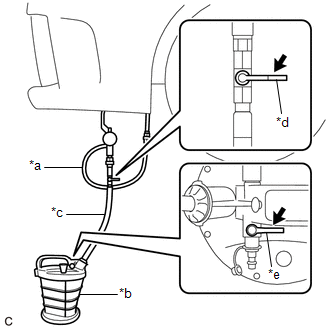 |
|
*a | SST (Vacuum Regulator) | |
*b | SST (Tank Assy) | |
*c | Hose of SST (Tank Assy) | |
*d | Valve Handle (Upper Valve) | |
*e | Valve Handle (Lower Valve) | | |
(p) Connect a compressed air hose to SST (tank assy).
NOTICE:
Do not apply 689 kPa (7.0 kgf/cm2, 100 psi) or more of compressed air to SST (tank assy).
| (q)
Open the lower valve of SST (tank assy) by turning the valve handle
(lower valve) so it is in-line with the compressed air hose. | |
(r)
Open the upper valve of SST (tank assy) by turning the valve handle
(upper valve) so it is in-line with the hose of SST (tank assy).
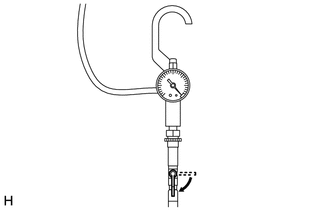
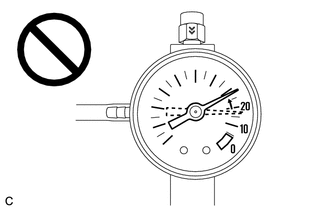
- Make sure to turn the valve handle (upper valve) slowly.
- Make sure the value on the gauge of SST (vacuum regulator) stays between
-10 and -20 kPa (-0.1 and -0.2 kgf/cm2, -1.5 and -2.9 psi).
- If the value on the gauge of SST (vacuum regulator) exceeds -20 kPa
(-0.2 kgf/cm2, -2.9 psi), make sure to turn the valve handle (upper
valve) so it is perpendicular to the hose of SST (tank assy)
immediately, otherwise parts inside the automatic transaxle assembly may
be damaged.
HINT:
Vacuum
will be applied to the automatic transaxle assembly when both of the
valves of SST (tank assy) are opened to prevent automatic transaxle
fluid loss when removing/installing the overflow plug.
| (s) Using a 10 mm hexagon socket wrench, remove the overflow plug and gasket from the transaxle housing.
CAUTION: A small amount of hot automatic transaxle fluid may leak from the overflow plug port during removal.
HINT: Place a container under the overflow plug to collect any automatic transaxle fluid that leaks out. |
|
| (t)
Install SST (adapter 18) to SST (overflow level gauge) and then install
SST (overflow level gauge) to the overflow plug hole by hand until it
is fully seated against the transaxle housing. SST: 09993-01100 SST: 09993-19025
09993-10010 09993-01010 NOTICE: Ensure
that the sliding tube of SST (overflow level gauge) is fully retracted
into the housing of SST (overflow lever gauge) before inserting it into
the overflow plug hole. HINT: The
level/measurement indicator on SST (overflow level gauge) will read 0
mm (0 in.) when the sliding tube of SST (overflow level gauge) is fully
retracted. |
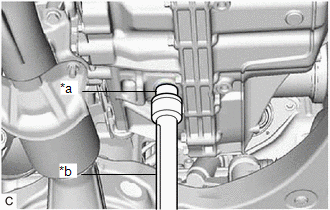 |
|
*a | SST (Adapter 18) | |
*b | SST (Overflow Level Gauge) | | |
(u)
Adjust SST (overflow level gauge) to the specified measurement
according to the table below and lock the sliding scale of SST (overflow
level gauge) by tightening the thumb screw.
Specified Measurement:
|
Specified Measurement at Automatic Transaxle Fluid Temperature of 85 to 90°C (185 to 194°F) |
|
Engine Idle Speed (rpm) 600 to 700 |
80 mm (3.15 in.) |
NOTICE:
Before
proceeding with the inspection, make sure the automatic transaxle fluid
temperature is between 85 to 90°C (185 to 194°F) and the engine idle
speed is within the specified range in the table above.
| (v)
Close the upper valve of SST (tank assy) by turning the valve handle
(upper valve) so it is perpendicular to the hose of SST (tank assy).
NOTICE:
- Make sure to turn the valve handle (upper valve) slowly.
- Make sure that the gauge of SST (vacuum regulator) reads 0 kPa (0 kgf/cm2, 0 psi).
HINT: Vacuum that was applied to the automatic transaxle assembly will not be applied when the valve handle (upper valve) is closed. |
|
(w) Check the automatic transaxle fluid flowing from the hose at the bottom of SST (overflow level gauge).
- If the amount of automatic transaxle fluid that comes out of SST (overflow level gauge) is large, proceed to step [#1].
- If no automatic transaxle fluid comes out of SST (overflow level gauge), proceed to step [#2].
(x) If the amount of automatic transaxle fluid that comes out of SST (overflow level gauge) is large. [#1]
(1) Wait until the automatic transaxle fluid flow slows and only drips come out.
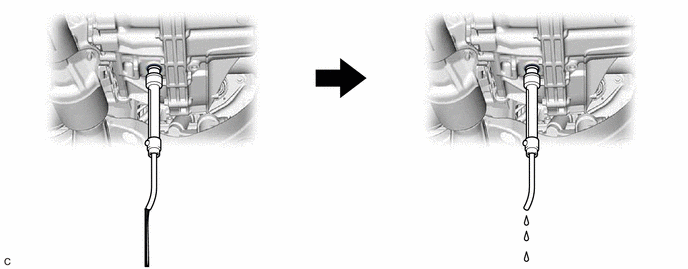
HINT:
The
automatic transaxle fluid flow will not stop completely because the
automatic transaxle fluid continues to expand as its temperature
increases.
(2) Open the upper valve of SST (tank assy)
by turning the valve handle (upper valve) so it is in-line with the
hose of SST (tank assy).


- Make sure to turn the valve handle (upper valve) slowly.
- Make sure the value on the gauge of SST (vacuum regulator) stays between
-10 and -20 kPa (-0.1 and -0.2 kgf/cm2, -1.5 and -2.9 psi).
- If the value on the gauge of SST (vacuum regulator) exceeds -20 kPa
(-0.2 kgf/cm2, -2.9 psi), make sure to turn the valve handle (upper
valve) so it is perpendicular to the hose of SST (tank assy)
immediately, otherwise parts inside the automatic transaxle assembly may
be damaged.
HINT:
Vacuum
will be applied to the automatic transaxle assembly when both of the
valves of SST (tank assy) are opened to prevent automatic transaxle
fluid loss when removing/installing the overflow plug.
(3) Remove SST (overflow level gauge) from the overflow plug hole.
(4) Using a 10 mm hexagon socket wrench, install the overflow plug and a new gasket to the transaxle housing.
Torque:
50 N·m {510 kgf·cm, 37 ft·lbf}
NOTICE:
To prevent the gasket from being deformed when tightening, coat it with Toyota Genuine ATF WS.
| (5)
Close the upper valve of SST (tank assy) by turning the valve handle
(upper valve) so it is perpendicular to the hose of SST (tank assy).
NOTICE:
- Make sure to turn the valve handle (upper valve) slowly.
- Make sure that the gauge of SST (vacuum regulator) reads 0 kPa (0 kgf/cm2, 0 psi).
HINT: Vacuum that was applied to the automatic transaxle assembly will not be applied when the valve handle (upper valve) is closed. |
|
| (6)
Close the lower valve of SST (tank assy) by turning the valve handle
(lower valve) so it is perpendicular to the compressed air hose. | |
(7) Disconnect the compressed air hose from SST (tank assy).
(8) Disconnect the hose of SST (tank assy) from SST (vacuum regulator).
(9) Disconnect SST (vacuum regulator) from SST (filler plug adapter).
(10) Remove SST (filler plug adapter) from the refill plug hole.
(y) If no automatic transaxle fluid comes out of SST (overflow level gauge). [#2]
| (1) Remove SST (filler plug adapter) from the refill plug hole. |
 |
|
*a | SST (Filler Plug Adapter) | | |
(2) Add automatic transaxle fluid through the refill plug hole until fluid comes out of SST (overflow level gauge).
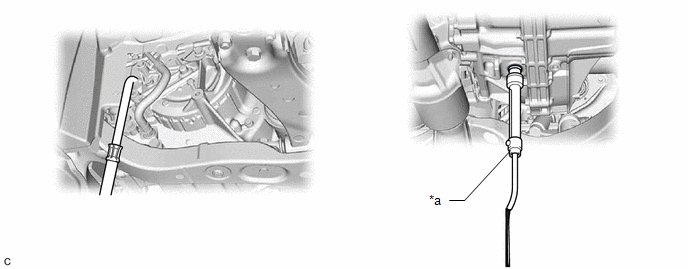
|
*a | SST (Overflow Level Gauge) |
- | - |
NOTICE:
Use Toyota Genuine ATF WS.
(3) Wait until the automatic transaxle fluid flow slows and only drips come out.

HINT:
The
automatic transaxle fluid flow will not stop completely because the
automatic transaxle fluid continues to expand as its temperature
increases.
| (4) Install SST (filler plug adapter) to the refill plug hole.
SST: 09993-19025 09993-10010 09993-01030 |
 |
|
*a | SST (Filler Plug Adapter) | | |
(5)
Open the upper valve of SST (tank assy) by turning the valve handle
(upper valve) so it is in-line with the hose of SST (tank assy).


- Make sure to turn the valve handle (upper valve) slowly.
- Make sure the value on the gauge of SST (vacuum regulator) stays between
-10 and -20 kPa (-0.1 and -0.2 kgf/cm2, -1.5 and -2.9 psi).
- If the value on the gauge of SST (vacuum regulator) exceeds -20 kPa
(-0.2 kgf/cm2, -2.9 psi), make sure to turn the valve handle (upper
valve) so it is perpendicular to the hose of SST (tank assy)
immediately, otherwise parts inside the automatic transaxle assembly may
be damaged.
HINT:
Vacuum
will be applied to the automatic transaxle assembly when both of the
valves of SST (tank assy) are opened to prevent automatic transaxle
fluid loss when removing/installing the overflow plug.
(6) Remove SST (overflow level gauge) from the overflow plug hole.
(7) Using a 10 mm hexagon socket wrench, install the overflow plug and a new gasket to the transaxle housing.
Torque:
50 N·m {510 kgf·cm, 37 ft·lbf}
NOTICE:
To prevent the gasket from being deformed when tightening, coat it with Toyota Genuine ATF WS.
| (8)
Close the upper valve of SST (tank assy) by turning the valve handle
(upper valve) so it is perpendicular to the hose of SST (tank assy).
NOTICE:
- Make sure to turn the valve handle (upper valve) slowly.
- Make sure that the gauge of SST (vacuum regulator) reads 0 kPa (0 kgf/cm2, 0 psi).
HINT: Vacuum that was applied to the automatic transaxle assembly will not be applied when the valve handle (upper valve) is closed. |
|
| (9)
Close the lower valve of SST (tank assy) by turning the valve handle
(lower valve) so it is perpendicular to the compressed air hose. | |
(10) Disconnect the compressed air hose from SST (tank assy).
(11) Disconnect the hose of SST (tank assy) from SST (vacuum regulator).
(12) Disconnect SST (vacuum regulator) from SST (filler plug adapter).
(13) Remove SST (filler plug adapter) from the refill plug hole.
(z) Install the refill plug and a new gasket to the automatic transaxle case sub-assembly.
Torque:
49 N·m {500 kgf·cm, 36 ft·lbf}
NOTICE:
To prevent the gasket from being deformed when tightening, coat it with Toyota Genuine ATF WS.
(aa) Disconnect the Techstream from the DLC3.
(ab) Lift the vehicle.
(ac) Clean each part.
(ad) Check for automatic transaxle fluid leaks.
(ae) Install the front fender apron seal LH.
Click here

(af) Install the rear engine under cover LH.
Click here 
(ag) Install the No. 1 engine under cover.
Click here 
(ah) Install the front wheel opening extension pad LH.
Click here 
(ai) Install the front wheel opening extension pad RH.
Click here 
(aj) Lower the vehicle.
Replacement
REPLACEMENT
CAUTION / NOTICE / HINT
The
necessary procedures (adjustment, calibration, initialization or
registration) that must be performed after parts are removed and
installed, or replaced during automatic transaxle fluid replacement are
shown below.
Necessary Procedures After Parts Removed/Installed/Replaced |
Replaced Part or Performed Procedure |
Necessary Procedure | Effect/Inoperative Function when Necessary Procedure not Performed |
Link |
| Replacement of automatic transaxle fluid |
ATF thermal degradation estimate reset |
The value of the Data List item "ATF Thermal Degradation Estimate" is not estimated correctly |
 |
PROCEDURE
1. REMOVE FRONT WHEEL OPENING EXTENSION PAD LH
Click here

2. REMOVE FRONT WHEEL OPENING EXTENSION PAD RH
Click here 
3. REMOVE NO. 1 ENGINE UNDER COVER
Click here 
4. REMOVE REAR ENGINE UNDER COVER LH
Click here 
5. REMOVE FRONT FENDER APRON SEAL LH
Click here 
6. REPLACE AUTOMATIC TRANSAXLE FLUID
Click here 
7. ADD SPECIFIED AMOUNT OF AUTOMATIC TRANSAXLE FLUID
Click here 
8. ADJUST AUTOMATIC TRANSAXLE FLUID TEMPERATURE (when Using the Techstream)
Click here 
9. ADJUST AUTOMATIC TRANSAXLE FLUID TEMPERATURE (when Not Using the Techstream)
Click here 
10. ADJUST AUTOMATIC TRANSAXLE FLUID LEVEL
Click here 
11. REBUILD WORK
Click here

12. INSTALL FRONT FENDER APRON SEAL LH
Click here 
13. INSTALL REAR ENGINE UNDER COVER LH
Click here 
14. INSTALL NO. 1 ENGINE UNDER COVER
Click here 
15. INSTALL FRONT WHEEL OPENING EXTENSION PAD LH
Click here 
16. INSTALL FRONT WHEEL OPENING EXTENSION PAD RH
Click here 









